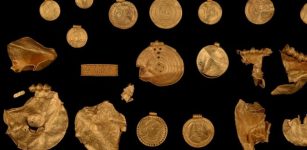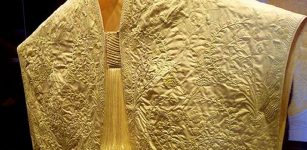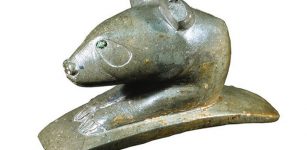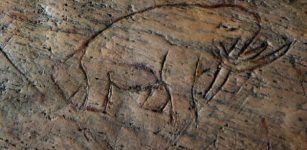Sirens: The Secret Of The Power In Their Captivating Song That Heralded Death
A. Sutherland - AncientPages.com - Usually, the Sirens were considered daughters of the river god Achelous, either by the Muse Terpsichore, Melpomene, Calliope, or by Sterope, daughter of King Porthaon of Calydon.
Ulysses and the Sirens. Herbert James Draper (1863–1920). Image uploader: Fanfwah - Public Domain
Their number is variously reported from two to eight. These creepy and not particularly beautiful mythological creatures initially had bird features, including feathered wings, clawed feet, and occasionally sparrow-like tails.
'Some say that the Sirens, who had lost their wings as a result of an unsuccessful singing contest with the Muses, sponsored by Hera, committed suicide because of their failure to outcharm Orpheus; yet they were still on their island when Odysseus came by a generation later...' 1
As time went on, the Sirens had fishtails and upper human bodies, and they were described and painted as beautiful young women. They came to be depicted with looks to match their wonderful voices, their temptations therefore magnified.
Where did these fascinating creatures come from? Their origin varies from source to source, but they tend to be claimed as the daughters of one god or another, with the sea god Phorcys or river god Achelous both contenders. Angels or women who stray from the path of righteousness were also linked with sirens and were said to be doomed to become one on the Day of Judgement.
In ancient Greek mythology, their image is undoubtedly appealing but also ruinous. According to one version of the story, searching the sea floor around their island would turn up ships wrecked as they made attempts to come closer to the Sirens.
Odysseus and the Sirens. Detail of an Attic red-figure stamnos by the Mermaid Painter (eponymous vase), circa 480-470 BC. AD Provenance: Vulci. Credit: British Museum; Image uploader: Jastrow - Public Domain
Few stories even describe the creatures as physically attacking humans, or perhaps their captivating song had dramatic consequences for sailors. Did they try to lure sailors to their deaths? Could it be another motif behind their enchanting song?
Was their song a kind of revenge, or perhaps it symbolized grief?
The sirens were exiled to a small, flowery, but lifeless islet of Anthemoesse, where they were forced to live alone. The sirens were usually seen on the sharp rocks off the coast. Possibly, they used their song as revenge for their unhappy life and all the wrongdoings committed against them.
As a result, they could become monsters and destroy the others' lives. Were the Sirens lonely, so they tried to attract men to accompany them on the island? Could it work with the help of an amazing song?
Sirens were almost always found at sea. Perhaps this is because sailors become defenseless in vast water realms and, therefore, more easily affected by the charms of sirens.
It is said that Anthemoessa was found covered with human remains; however, no sign that the mythical sirens killed these people was ever seen.
D. W. Waterhouse , Odysseus and the Sirens , 1891 - Public Domain
The sailors could die of starvation because their ships were destroyed in the area. In one account, Anthemoessa was the island home of the Sirens. Still, in others, their home was associated with the Sirenuse islands near Paestum, the island of Ischia, or Capri, located in the Gulf of Naples.
All these locations were described to be surrounded by dangerous cliffs and rocks and exposed to storms and strong winds.
Supernatural Abilities Of The Sirens
The Sirens had the ability to turn into beautiful and captivating temptresses.
Their delightful voice caused the sailors to be totally bewitched. Forgetting everything, the men crashed on the rocks.
In his "Seers, shrines and Sirens," American researcher John Pollard writes that the works of art often have demonstrated the connection of sirens with various symbols. These symbols are preserved in literature, not counting the depictions of sirens on ancient tombstones. The sirens are associated with Odysseus and his companions, often depicted next to Theseus, Dionysus, Artemis, and Athena.
Damaged siren sculpture. Athens, 370 BC e. Image credit: Marsyas - CC BY 2.5
These creatures were almost always depicted as females. However, in earlier times, they had beards, heralding death and leading to death. They even caused mysterious pleasure caused by their singing.
Traveling to Ithaca, Odysseus must have passed by the island, the seat of the mermaids. But he knew what danger lurked in these hellish seductresses. So he ordered his companions to cover their ears with wax so they would not hear the siren singing; thus, they were not susceptible to his charm.
However, Odysseus himself decided not to waste his only chance. He ordered himself to be tied with strong naval lines to the mast and ordered that no one under no circumstances tried to untie him. At least he begged for it. As the boat drifted closer, the sirens began their deadly chant.
However, no one heard anything. Odysseus, at this time, was tearing up and struggling horribly. He shouted and ordered it to be removed. But no one listened to him. Thanks to this trick, a group of travelers avoided this mortal danger. Odysseus, on the other hand, could be proud that he was the only living man to hear the wonderful siren singing.
Written by – A. Sutherland - AncientPages.com Senior Staff Writer
Copyright © AncientPages.com All rights reserved. This material may not be published, broadcast, rewritten or redistributed in whole or part without thexpress written permission of AncientPages.com
Expand for referencesReferences:
- Graves, Robert. The Greek Myths
Pietro Pucci, The Song of the Sirens and Other Essays
Kopaliński W: Słownik mitów i tradycji kultury.
More From Ancient Pages
-
 Early Christian Necropolis Unearthed In Sant’Appianu Cathedral In Sagone, Corsica
Archaeology | Aug 3, 2020
Early Christian Necropolis Unearthed In Sant’Appianu Cathedral In Sagone, Corsica
Archaeology | Aug 3, 2020 -
 3D Scan Will Uncover Secrets Of The Magnificent Vindelev Gold Treasure
Archaeology | Oct 25, 2023
3D Scan Will Uncover Secrets Of The Magnificent Vindelev Gold Treasure
Archaeology | Oct 25, 2023 -
 The Man Who Took The Greatest Alchemy Secret Of All Time To His Grave
Ancient Mysteries | Jul 16, 2020
The Man Who Took The Greatest Alchemy Secret Of All Time To His Grave
Ancient Mysteries | Jul 16, 2020 -
 Scottish Settler’s Ominous Encounter With A Mysterious Being In West Virginia
Featured Stories | Mar 18, 2024
Scottish Settler’s Ominous Encounter With A Mysterious Being In West Virginia
Featured Stories | Mar 18, 2024 -
 Five Witchcraft Myths Debunked By An Expert
Featured Stories | Oct 27, 2023
Five Witchcraft Myths Debunked By An Expert
Featured Stories | Oct 27, 2023 -
 Magnificent Golden Silk Cloth Made By 1 Million Spiders Is One Of The World’s Rarest Silk Textiles
Artifacts | May 20, 2021
Magnificent Golden Silk Cloth Made By 1 Million Spiders Is One Of The World’s Rarest Silk Textiles
Artifacts | May 20, 2021 -
 Was The Discovery Of Biblical Abel’s Giant Grave In Syria Covered-Up?
Ancient Mysteries | Oct 28, 2014
Was The Discovery Of Biblical Abel’s Giant Grave In Syria Covered-Up?
Ancient Mysteries | Oct 28, 2014 -
 Use Of Tobacco Pipes By Hopewell People Tells A New Story
Archaeology | Jun 28, 2021
Use Of Tobacco Pipes By Hopewell People Tells A New Story
Archaeology | Jun 28, 2021 -
 How Greenland Got The ‘Wrong’ Name Thanks To Viking Erik The Red
Ancient History Facts | Mar 21, 2017
How Greenland Got The ‘Wrong’ Name Thanks To Viking Erik The Red
Ancient History Facts | Mar 21, 2017 -
 Archaeologists Uncover Secrets Of ‘Vallø Borgring’ Viking Age Circular Fortress
Archaeology | Oct 11, 2015
Archaeologists Uncover Secrets Of ‘Vallø Borgring’ Viking Age Circular Fortress
Archaeology | Oct 11, 2015 -
 48,000-Year-Old Tooth That Belonged To Neanderthal Child Found In Northern Italy
Fossils | Sep 19, 2020
48,000-Year-Old Tooth That Belonged To Neanderthal Child Found In Northern Italy
Fossils | Sep 19, 2020 -
 Early Humans Were Probably Driven To Extinction By Climate Change- Study Suggests
Civilizations | Oct 15, 2020
Early Humans Were Probably Driven To Extinction By Climate Change- Study Suggests
Civilizations | Oct 15, 2020 -
 Gigantic Ancient Palace Unearthed In Mexico’s Valley Of Oaxaca
Archaeology | Mar 29, 2017
Gigantic Ancient Palace Unearthed In Mexico’s Valley Of Oaxaca
Archaeology | Mar 29, 2017 -
 Mysterious Ancient Inscription With Unknown Language Found Near Lake Bashplemi, Georgia
Linguistic Discoveries | Dec 4, 2024
Mysterious Ancient Inscription With Unknown Language Found Near Lake Bashplemi, Georgia
Linguistic Discoveries | Dec 4, 2024 -
 Mayan Elites Lived In Pre-Hispanic Teotihuacán – New Evidence
Archaeology | Sep 27, 2018
Mayan Elites Lived In Pre-Hispanic Teotihuacán – New Evidence
Archaeology | Sep 27, 2018 -
 Frigg: Chief Norse Goddess Who Knew Secrets Of Humans’ Fates
Featured Stories | Dec 13, 2022
Frigg: Chief Norse Goddess Who Knew Secrets Of Humans’ Fates
Featured Stories | Dec 13, 2022 -
 Paleolithic Humans May Have Understood The Properties Of Rocks For Making Stone Tools
Archaeology | Dec 2, 2023
Paleolithic Humans May Have Understood The Properties Of Rocks For Making Stone Tools
Archaeology | Dec 2, 2023 -
 Mysterious Sleeping Beauty Of Loulan Mummy Is Still Perfectly Preserved After 3,800 Years!
Civilizations | Oct 30, 2014
Mysterious Sleeping Beauty Of Loulan Mummy Is Still Perfectly Preserved After 3,800 Years!
Civilizations | Oct 30, 2014 -
 Controversial Study Of Ancient DNA Could Re-Write History Of South Florida And Prove Humans And Huge Prehistoric Animals Co-Existed
Archaeology | Sep 23, 2014
Controversial Study Of Ancient DNA Could Re-Write History Of South Florida And Prove Humans And Huge Prehistoric Animals Co-Existed
Archaeology | Sep 23, 2014 -
 Remains Of A Roman Ship Discovered In Serbia
Archaeology | Aug 7, 2023
Remains Of A Roman Ship Discovered In Serbia
Archaeology | Aug 7, 2023




